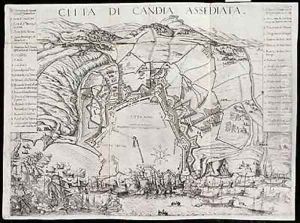Marco Boschini Paintings
Marco Boschini was an Italian painter, engraver, and art theorist born in Venice in 1613. He is best known for his contributions to the Venetian art scene during the 17th century, a period marked by a transition from the Renaissance to the Baroque style. Boschini's work and writings offer insight into the artistic milieu of his time, especially in the context of Venetian painting. Although not as widely recognized as some of his contemporaries, Boschini played a significant role in documenting and promoting the Venetian school of painting.
Boschini's early life is not well documented, but it is known that he began his career as an engraver and painter, producing works that reflected the rich artistic environment of Venice. His engravings and paintings are characterized by detailed representation and a deep appreciation for the Venetian landscape and architecture. However, it is his literary contributions that have garnered the most attention from art historians. Boschini's most notable work, 'La Carta del Navegar Pitoresco' (The Map of the Picturesque Journey), published in 1660, serves as a guide to the Venetian paintings of his time. This work not only provides valuable insights into the artists and artworks of 17th-century Venice but also articulates Boschini's aesthetic theories, including his defense of the Venetian colorito (coloring) over the Florentine disegno (drawing).
Throughout his career, Boschini was deeply involved in the intellectual and artistic debates of his time, often taking a staunch position in favor of the Venetian tradition of painting. His writings articulate a deep-seated belief in the supremacy of color and light, hallmarks of Venetian painting, over the more linear and sculptural approach favored by the Florentine and Roman schools. This advocacy for the Venetian style helped to articulate the city's unique artistic identity during a period of significant stylistic shifts.
Marco Boschini's legacy extends beyond his paintings and engravings to his influential writings on art. Through 'La Carta del Navegar Pitoresco' and his other works, Boschini left an indelible mark on the understanding and appreciation of Venetian art. His detailed descriptions of artworks, coupled with his theoretical discussions, provide a rich source of information for historians studying the evolution of Venetian painting. Boschini died in Venice in 1678, leaving behind a body of work that continues to inform and enrich the study of 17th-century Italian art.
